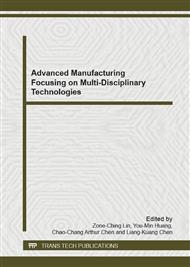p.78
p.86
p.92
p.101
p.109
p.118
p.124
p.134
p.145
Effect of Tool Geometry on Strength of Friction Stir Spot Welded Aluminum Alloys
Abstract:
The effects of tool geometry on the microstructure and tensile shear strength of friction stir spot-welded A6061-T6 Al alloy sheets were investigated in the present study. Friction stir spot welding (FSSW) was carried out at a tool speed of 2500 rpm, plunging rate of 1 mm/s, and dwell time of 3 s. Four types of tools with the same shoulder shape and size, but different pin profiles (threaded cylindrical, smooth cylindrical, threaded triangular, and smooth triangular) were used to carry out FSSW. The mechanical and metallurgical properties of the FSSW specimens were characterized to evaluate the performance of the different tools. Experimental results show that the pin profile significantly alters the hook geometry, which in turn affects the tensile shear strength of the friction stir spot welds. The welds made using the conventional thread cylindrical tool have the largest elongation and yield the highest tensile strength (4.78 kN). The welds made using the smooth cylindrical tool have the lowest tensile strength. The welds made using the threaded triangular and smooth triangular tools both have a tensile-shear load of about 4 KN; however, the welds made using the threaded triangular tool have a better elongation than those made using the smooth triangular tool.
Info:
Periodical:
Pages:
109-117
Citation:
Online since:
October 2012
Authors:
Keywords:
Price:
Сopyright:
© 2012 Trans Tech Publications Ltd. All Rights Reserved
Share:
Citation:


